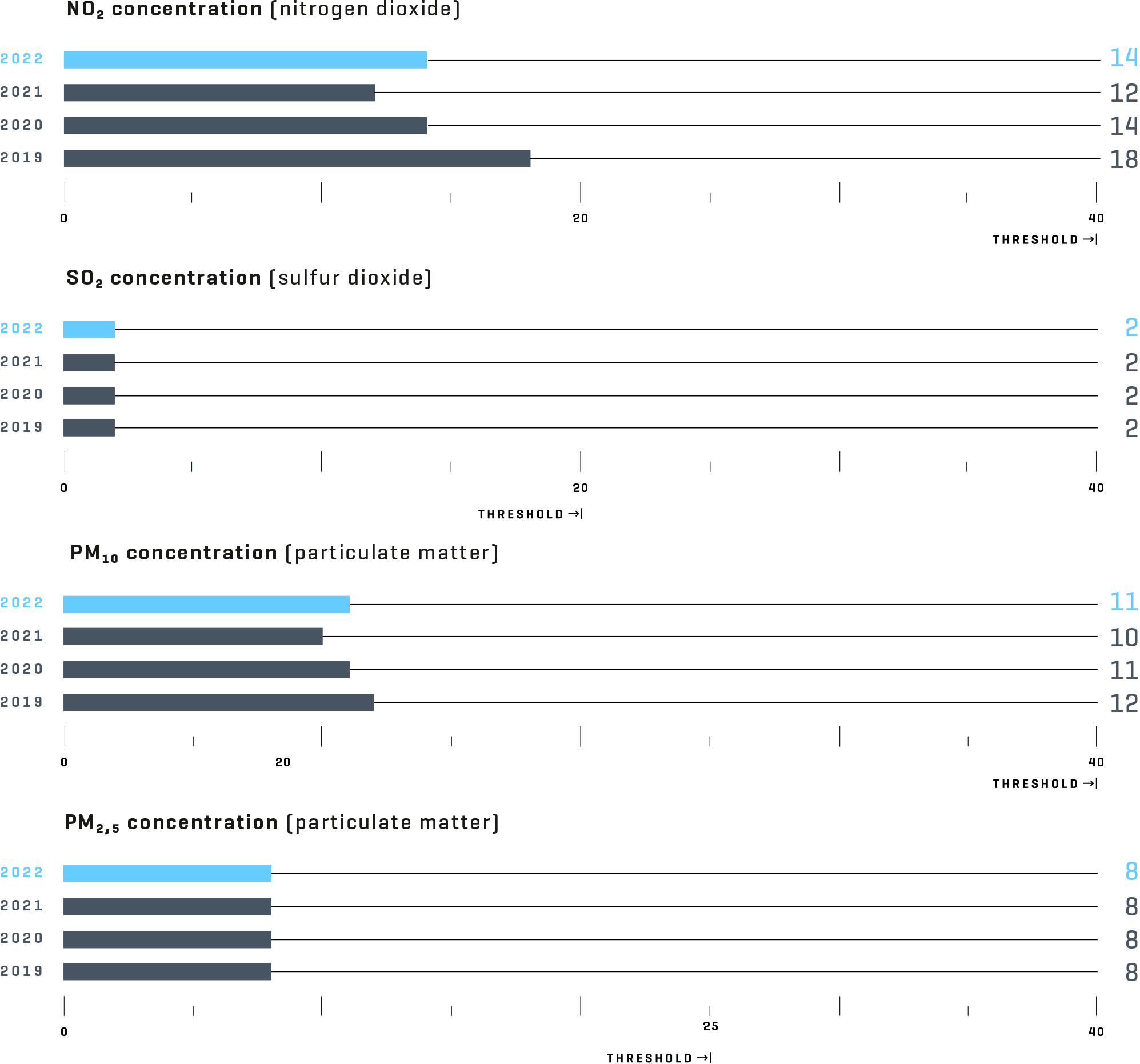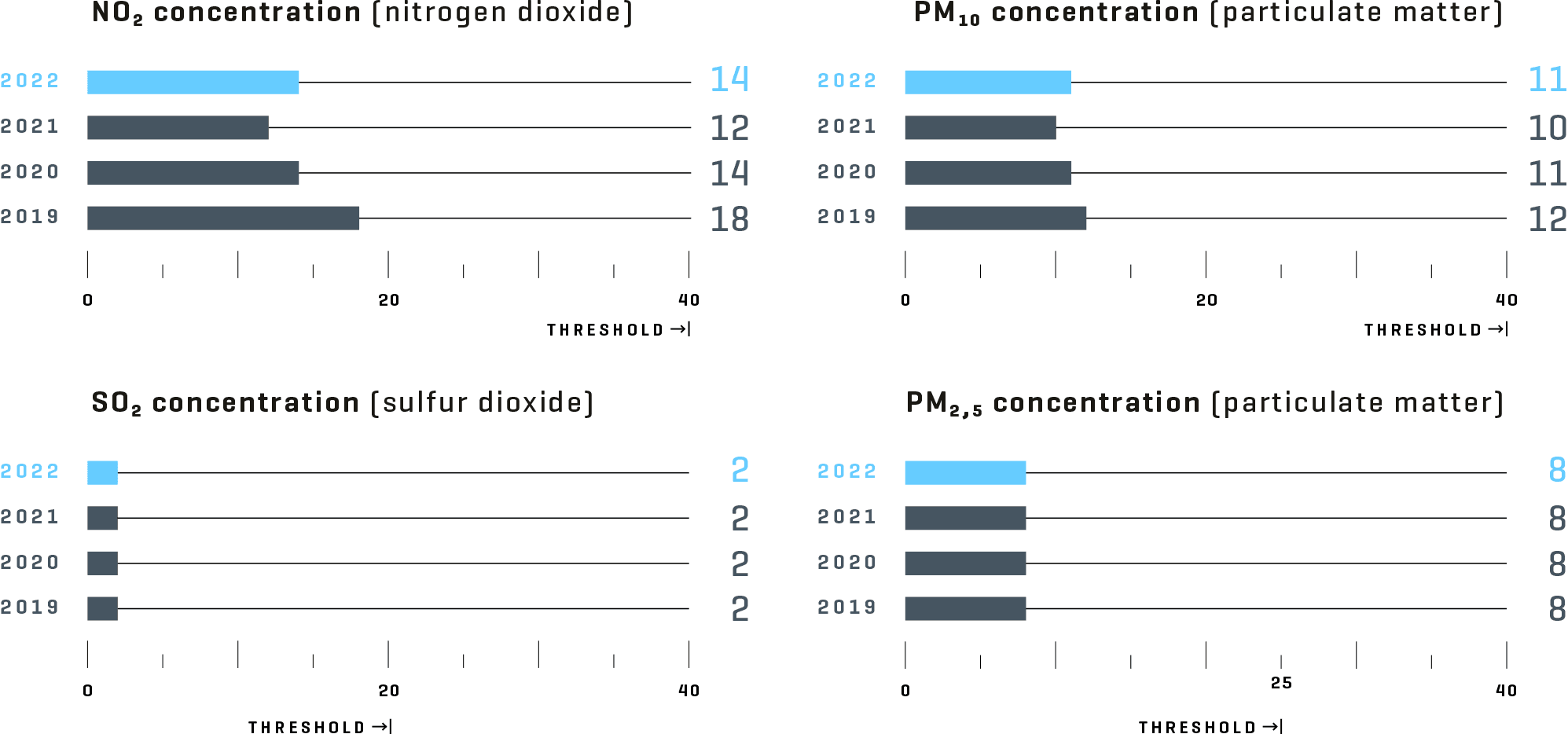Climate protection
Targeted measures reduce CO₂ emissions
Traffic numbers, which recovered strongly in 2022, led to an increase in CO₂ emissions attributable to the airport to 90,352 tonnes. This was just below the pre-Corona pandemic level. The exceptionally high demand for cooling buildings, facilities, and aircraft during 2022, the warmest year since the beginning of weather recordings, also contributed to this increase.
The focus of reporting, as in 2021, is on technical measures to specifically reduce CO₂ emissions, not on comparisons with previous years. In 2022, Flughafen München GmbH invested around 2.8 million euros to reduce greenhouse gas emissions by 3,216 tonnes over the long term through 28 additional individual measures. Thanks to the 333 measures already implemented since 2005, we have been able to reduce our CO₂ emissions by more than 55,113 tonnes of CO₂ per year. With the sharp rise in passenger numbers, specific CO₂ emissions per passenger fell to 2.85 kilograms (Scope 1 and 2) in 2022.
CO₂ emissions
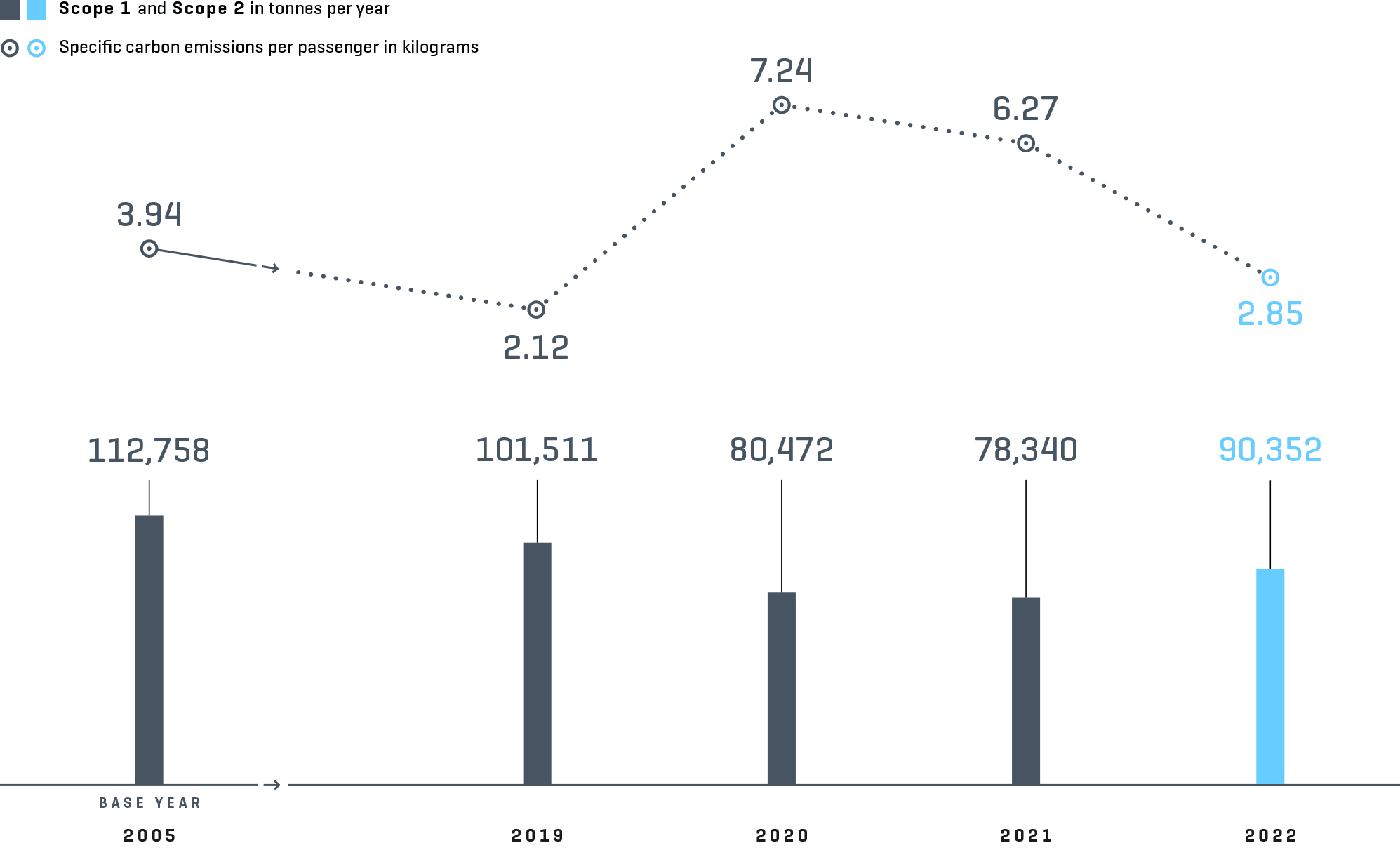

Footprint: complex math problem
The operation of a large infrastructure facility involves emissions from a wide variety of polluters. They are all included in the balancing of an airport’s greenhouse gas emissions. Emissions from air traffic in the landing-and-takeoff cycle (LTO cycle: aircraft landing and taking off at altitudes up to 3,000 feet) account for the largest share. The carbon footprint provides the basis for recording all forms of emissions and lends itself to comparison. It breaks down all greenhouse gas emissions that can be attributed to the airport into three different sources (scopes) according to an international standard, the «Greenhouse Gas Protocol».
Greenhouse gas emissions
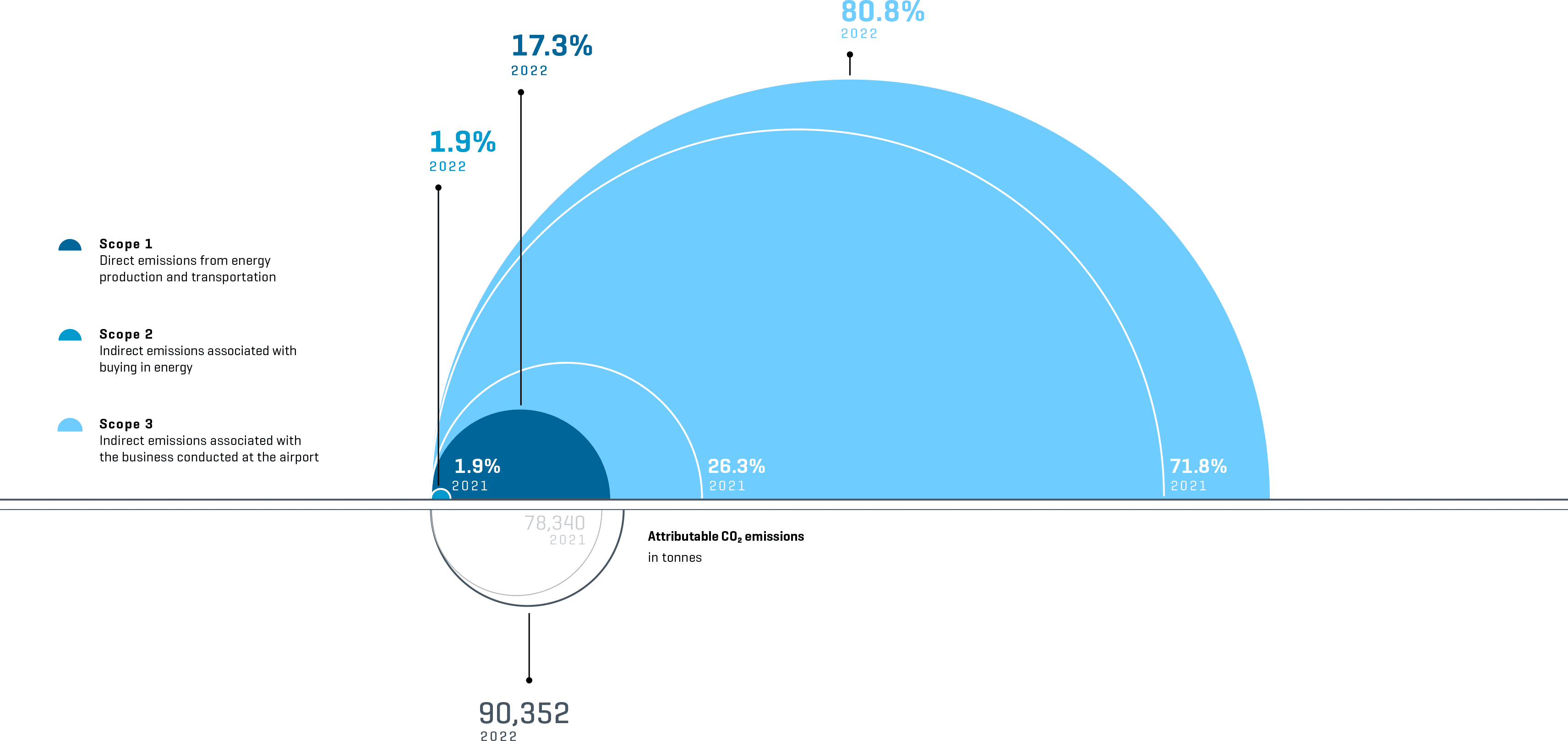

Scope 1 and Scope 2
REGENERATIVE ENERGY CONCEPT
Munich Airport set itself the goal of making almost its entire energy supply carbon-neutral by 2030, using as many available resources in the region as possible. To achieve this, for example, additional photovoltaic systems are to go into operation on parking garages, freight modules, and suitable open spaces starting in 2023. In the future, the primary energy supply of the combined heat and power plant is to be switched to biogas. In addition to climate protection, the high energy prices and dependence on Russian natural gas are another argument for pushing for energy self-sufficiency.
TARGET: EXPANSION OF PHOTOVOLTAIC SYSTEM
- 20 MW on roof areas
- 30 MW on open areas
- Over 50,000 MWh of solar power
- Equivalent to the electricity consumption of nearly 15,000 households
- Over 19,000 tonnes of CO₂ savings per year
Biogas plant


Ecological resource cycle in new biogas plant
Munich Airport plans to use biomethane from biowaste as fuel for its combined heat and power plant in the future. This lighthouse project preserves the principle of cogeneration at Munich Airport.
ENERGY CRISIS: SAVING WHEREVER POSSIBLE
In 2022, the special task force «Energy» at Munich Airport coordinated the energy-saving measures prescribed by law. Altogether, more than 70 measures were taken, such as the shutdown of 7,000 light points, including the MAC roof and the large M logos at the airport entrances. The parking garage interior lighting was reduced to the minimum illuminance required by the building permit, the room setpoint temperature was minimized, and the operation of the ventilation systems was modified. All of this resulted in savings of around 2,500 tonnes of CO₂ per year. At the same time, the special task force developed a phased plan to maintain flight operations despite a strained gas supply situation.
TOP 3 MEASURES
ENERGY-SAVING LED LIGHTING
Munich Airport has already shifted the entire apron lighting to energy-saving LED technology. All measures taken in the area of lighting have brought savings amounting to about 17,800 tonnes of CO₂. Retrofitting to LEDs is planned step by step for all building types. Brightness sensors and motion detectors provide additional savings.
REPLACEMENT OF THE VENTILATION SYSTEMS ON THE ENTIRE AIRPORT CAMPUS
More than 200 ventilation systems are in operation throughout the airport campus, supplying the buildings with fresh air. In line with the climate protection strategy, these are gradually being replaced by fans of the latest generation. As part of an initial project, we have optimized a total of 64 units since 2021. The project, which had a budget of around two million euros, got off to a slow start due to delays in deliveries, but was successfully continued in 2022 in the Hilton hotel as well as in passenger and office areas.
OPTIMIZATION OF HEAT DEMAND
Various measures reduced the demand for heat in 2022. Through the energy-efficient renovation of the roof in seven modules within the cargo area, along with the optimization of heating programming, a total of approximately 60 tonnes of CO₂ emissions were saved.
EFFICIENT DRIVES WITHIN THE FLEET
Munich Airport has already tested several alternative drive concepts. Among them are the launch of the world's first public hydrogen filling station, as well as trials with biogas, bioethanol, biodiesel and C.A.R.E. diesel. In addition, we currently operate 131 cars and vans and 304 handling and special vehicles with electric drives. By 2030, electric vehicles should comprise the lion’s share of the vehicle fleet. Since hardly any new vehicles were procured in 2022 due to the pandemic, they still account for just over 30 percent. With an eye to advances in technology, the vehicle mix will be even more diversified by 2030 through improvements in battery technology, green hydrogen, synthetic fuels, and other alternative drive concepts.
The German Federal Ministry of Digital Affairs and Transport has awarded Munich Airport funding amounting to almost 24 million euros. This grant will support the purchase of up to 72 electrically powered passenger buses, including the necessary charging infrastructure, at Munich Airport. AeroGround, which is responsible for passenger and crew transportation at Munich Airport, plans to convert its entire bus fleet to electric propulsion by 2025, with an investment of up to 60 million euros.
Excerpt from the electricity savings program projects completed in 2022 (Scope 1 and 2)
| Issue | Measure | Carbon reductions per year |
|---|---|---|
| Air conditioning | Conversion of the ventilation systems in Terminal 2 | 571 t |
| Conversion of the ventilation systems in the MAC (construction phase 2) | 433 t | |
| Lighting | Conversion to LED technology in parking garage P1 and P2 | 162 t |
| Conversion to LED technology in parking garage P20 (construction phase 1) | 109 t | |
| Conversion of the large display in Terminal 2 to LED technology | 31 t | |
| Vehicles | Electrification of vehicle fleet | 102 t |
| Other energy efficiency | Roof renovation for more energy efficiency | 15 t |
SCOPE 3
DHL Express Germany has started construction of a highly sustainable and energy-efficient building at the campus. The company is planning to meet all of its heating requirements through heat pump technology, as well as minimizing the amount of electricity it draws from the grid through a photovoltaic system. Plenty of charging locations for electric vehicles should also help avoid fossil fuels.
Air quality
At a glance: Nitrogen oxides, sulfur dioxide and particulate matter
In terms of air pollutants, as with CO₂, the aircraft cause significantly more emissions than the ground traffic on the aprons, feeder roads, and service roads. It is not possible, however, to differentiate between the immissions metrologically. Nitrogen oxides, sulfur dioxide, and particulate matter are key factors in assessing air quality at the airport and in its environs. Concentrations of these substances are continuously measured at two points. The measurement stations in the west and east of the airport record the effect of pollutant sources from road and air traffic, and other airport operations – superimposed on the background pollution from the Munich metropolitan area and the natural background concentration in the atmosphere.
In the wake of the Covid-19 pandemic, traffic-related emissions at Munich Airport declined significantly. This is particularly evident for nitrogen dioxide (NO₂): In 2022 NO₂ concentrations were below the level of 2019, the year before the crisis, but slightly higher than in the previous year. All applicable statutory limit values were observed in 2022. Mobile measurements were taken in 2022 on the north runway at Munich Airport and on the Volksfestplatz in Hallbergmoos. The concentrations were significantly below the statutory limits.
Real-time air quality measurements
Air quality
Fewer pollutants, lower landing charge
FMG charges emissions-based landing charges. Our aim is to motivate engine manufacturers and aircraft builders to invest more in the development of aircraft that produce less in the way of pollutant emissions. Munich Airport is thus helping to better environmental quality in its environs. Based on the types of aircraft that have landed, we can record and assess the pollutants, including CO₂, for the specific engines, and directly map the technical progress.
Ultrafine particles: smaller than 0.1 micrometer
There is no standardized procedure at present to measure ultrafine particles (UFP), no objective benchmark for their assessment, and also no limit values. However, we are closely monitoring current projects that address ultra-fine particulate pollution from air traffic. In the vicinity of Frankfurt Airport, the Hessian State Office for Nature Conservation, Environment and Geology is currently carrying out intensive UFP measurements. In the vicinity of Munich Airport, the University of Bayreuth has also been measuring UFP concentrations at Stadtgärtnerei in Freising and at the Volksfestplatz in Hallbergmoos since spring 2021 on behalf of the Bavarian Ministry of the Environment. FMG provides support for this by measuring other air quality parameters with the mobile measuring station at the Hallbergmoos site, but does not carry out any UFP measurements itself.
Continuous monitoring of pollutants
Long-lasting pollutants can accumulate in the environment and therefore seep into the food chain. Munich Airport has been monitoring this situation for many years using a variety of methods. In 2022, plant pots containing Italian ryegrass and kale as well as pots for collecting dustfall were set up at five monitoring points in the surrounding area. Honey monitoring also continued in 2022 with about 30 bee colonies around the airport.
Measuring points for air quality and biomonitoring
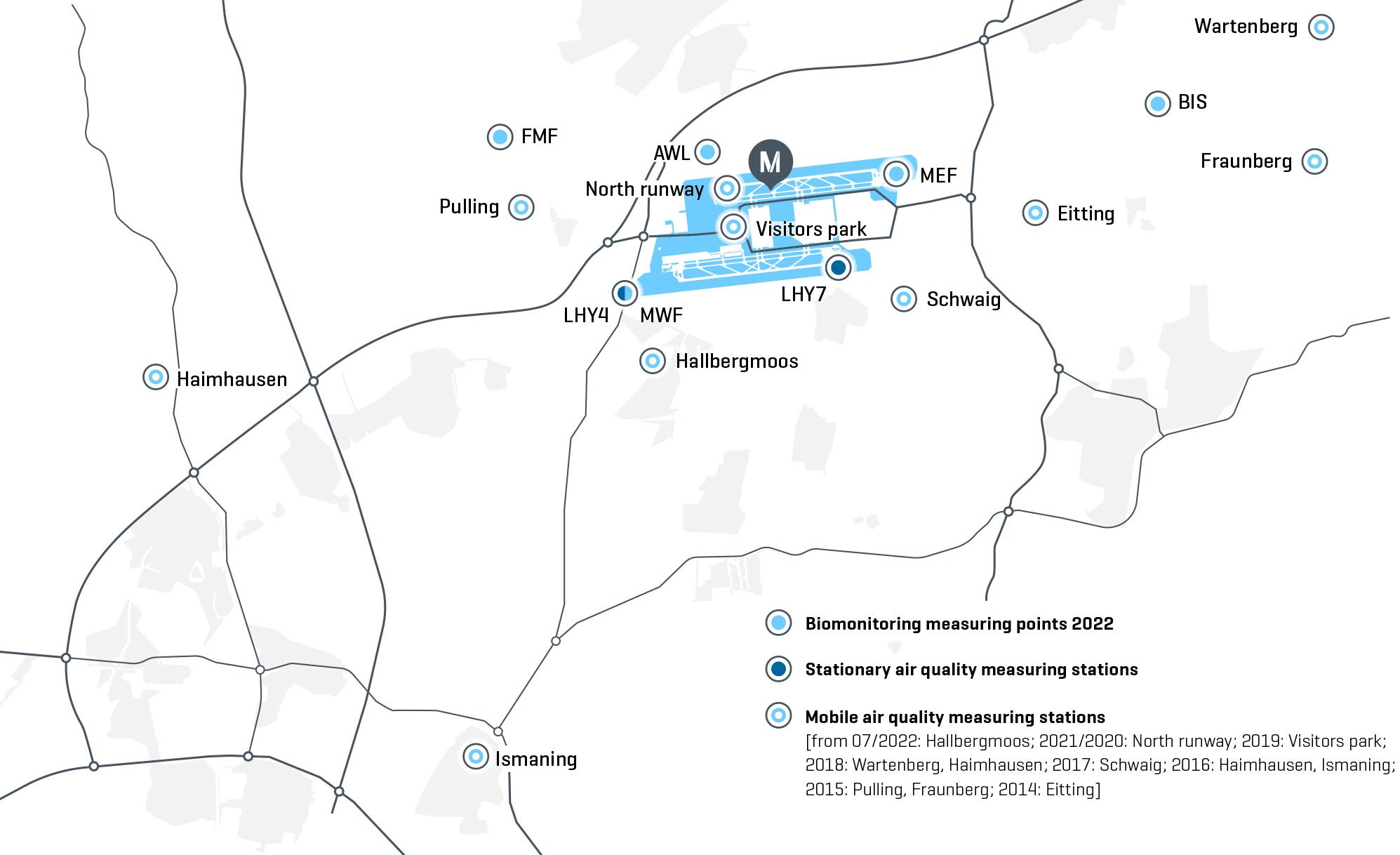

Pollutant concentrations at the measuring point to the east of the airport grounds
Annual average values in μg/m3
